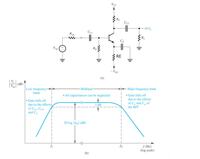paulmdrdo
Full Member level 3

Hello! I'm having a problem answering the following objective questions from my book about troubleshooting bjt amplifiers.
For item 19, I answered A and D
Assuming the coupling capacitor is open (either the input coupling cap or output coupling cap) the ac output voltage would be zero. But if the bypass capacitor is open the ac output voltage just decreases but not go to zero. But the answer in my book is A. This is confusing because the question says "any capacitor is open", there are two possible answer A and D.
For item 23, I answered C.
My reason is, if the emitter resistor is open and by using a.c equivalent of the circuit (where we short the bypass capacitor to ground) the open emitter resistor won't matter. And the resistance looking in at the base is Br'e(this is the same resistance if the emitter resistor i not open). Therefore the ac input voltage remains the same. But in my book the answer is B
For item 24, I answered C
Here, since Rc is in the output circuit it does not affect the ac input voltage. But in the book the answer is A.
For item 25, I answered c.
In a.c equivalent circuit tge emitter is already shorted to ground. Again, the resistance looking in at the base s Br'e( this is the same when the bypass cap is not shorted) therefore C was my answer. The only way(I know) ac input voltage would decrease is when the input resistance looking in at the base decreases.
For item 27, I answered B.
But not quite sure if my analysis is correct.
Please share to me your thoughts on this and any correction in my analysis would be appreciated.
For item 19, I answered A and D
Assuming the coupling capacitor is open (either the input coupling cap or output coupling cap) the ac output voltage would be zero. But if the bypass capacitor is open the ac output voltage just decreases but not go to zero. But the answer in my book is A. This is confusing because the question says "any capacitor is open", there are two possible answer A and D.
For item 23, I answered C.
My reason is, if the emitter resistor is open and by using a.c equivalent of the circuit (where we short the bypass capacitor to ground) the open emitter resistor won't matter. And the resistance looking in at the base is Br'e(this is the same resistance if the emitter resistor i not open). Therefore the ac input voltage remains the same. But in my book the answer is B
For item 24, I answered C
Here, since Rc is in the output circuit it does not affect the ac input voltage. But in the book the answer is A.
For item 25, I answered c.
In a.c equivalent circuit tge emitter is already shorted to ground. Again, the resistance looking in at the base s Br'e( this is the same when the bypass cap is not shorted) therefore C was my answer. The only way(I know) ac input voltage would decrease is when the input resistance looking in at the base decreases.
For item 27, I answered B.
But not quite sure if my analysis is correct.
Please share to me your thoughts on this and any correction in my analysis would be appreciated.





